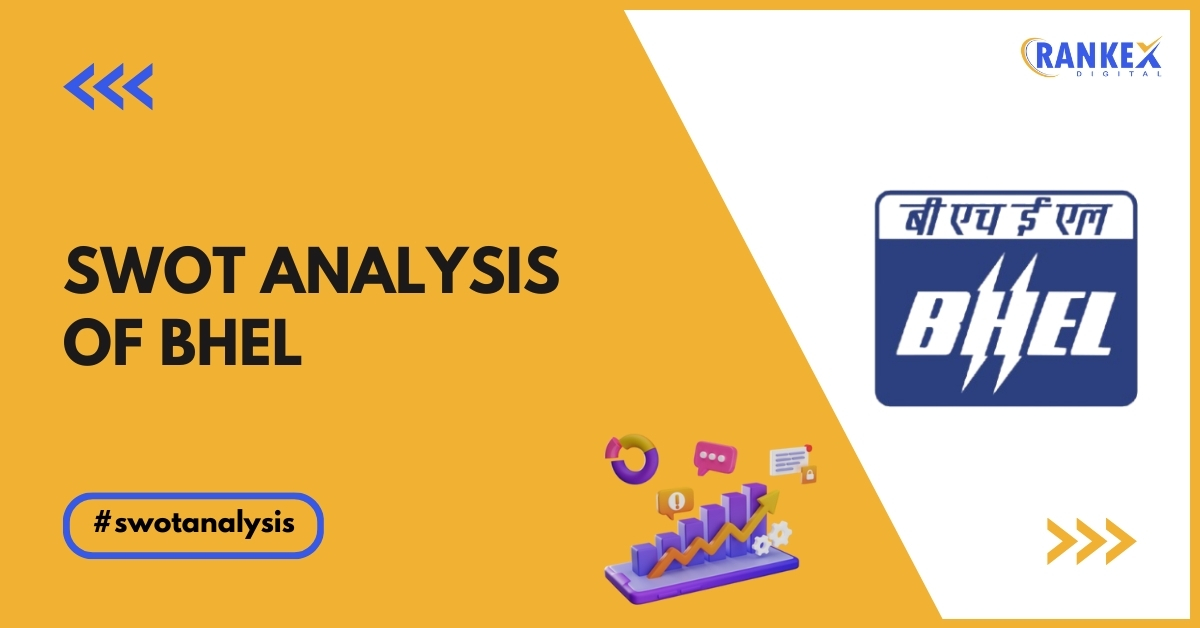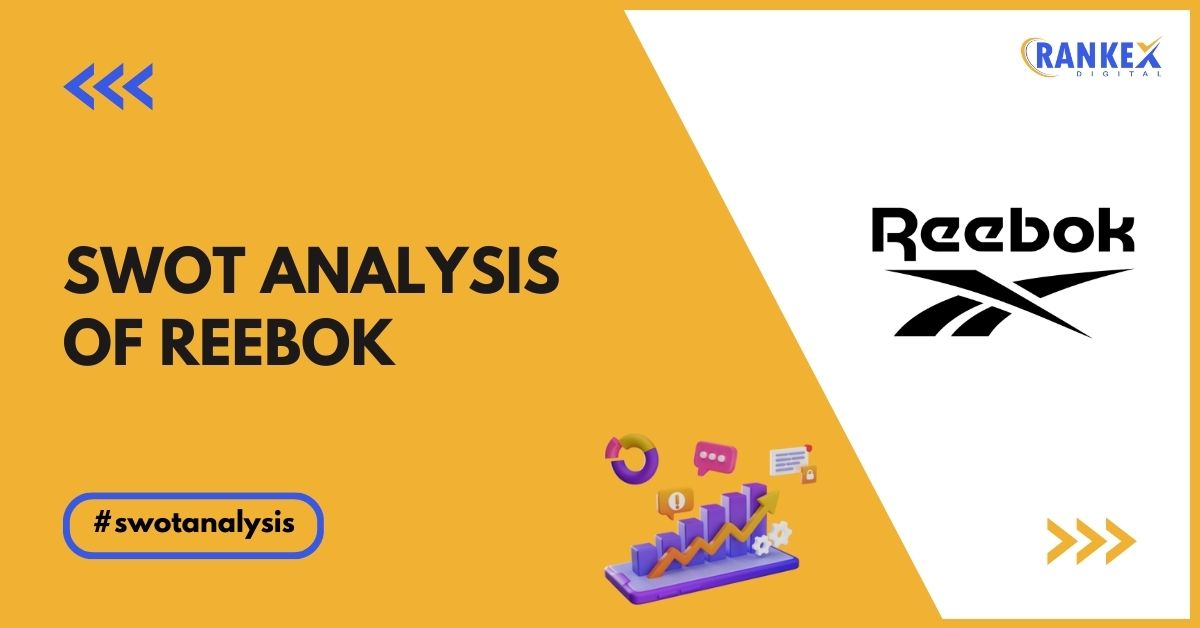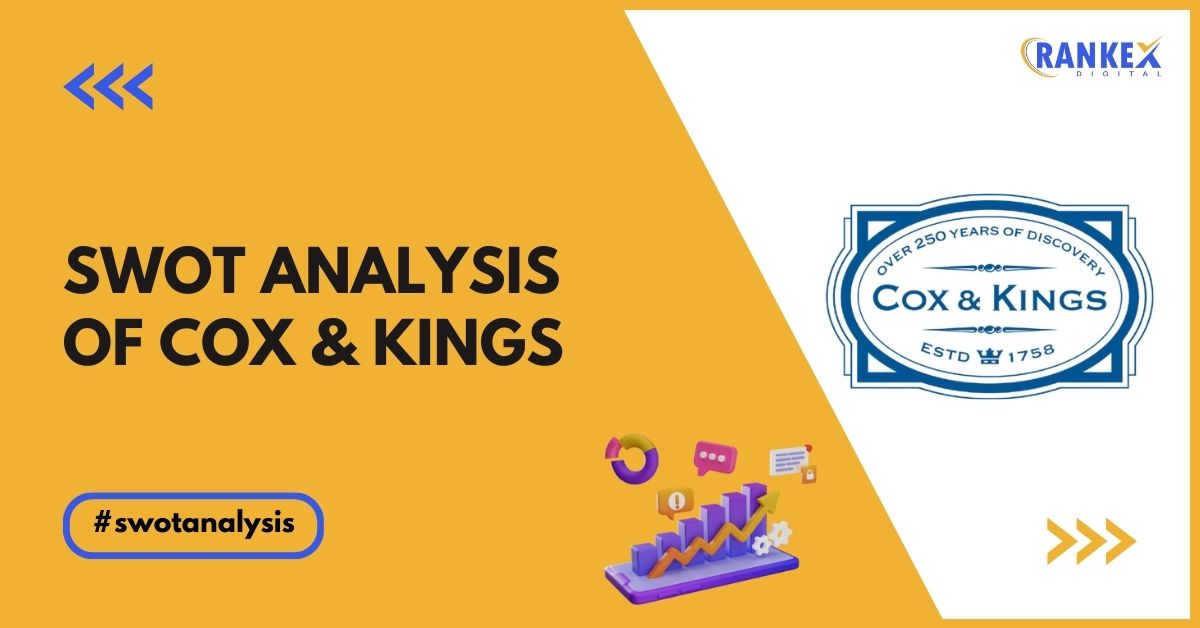Bharat Heavy Electricals Limited (BHEL) is India’s largest engineering and manufacturing company in the energy and industrial sectors. Founded in 1964, BHEL has played a pivotal role in the country’s power generation and infrastructure development.
The company’s portfolio includes power generation equipment, transmission, transportation, renewable energy solutions, and various industrial products. As India aims for self-reliance in industrial sectors, BHEL’s position is critical in supporting the nation’s energy demands and infrastructure growth.
Understanding the SWOT analysis of BHEL provides valuable insights into its current standing, industry dynamics, and strategic direction.
Table of Contents
Overview of BHEL
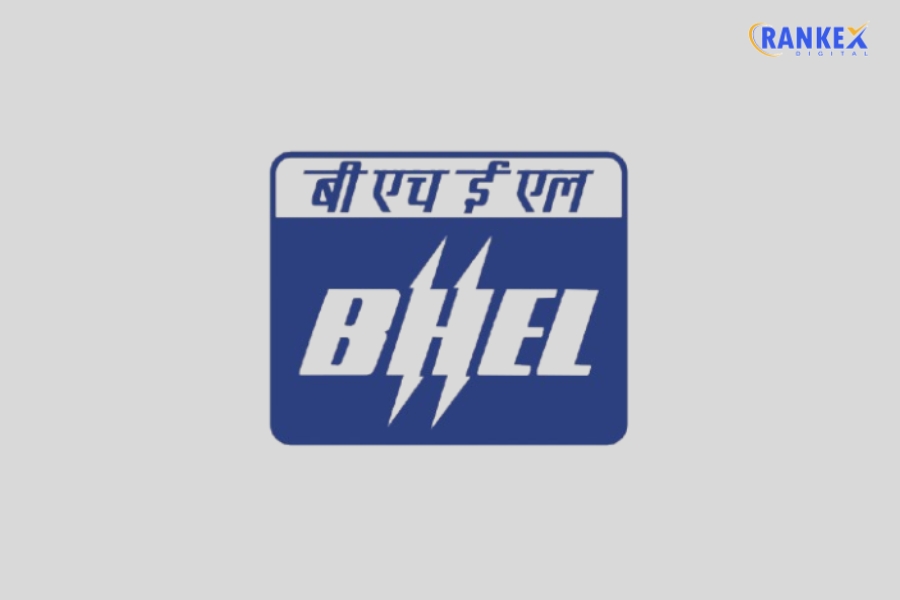
BHEL, headquartered in New Delhi, India, specializes in engineering, manufacturing, construction, testing, and servicing products across the energy sector and other industrial domains. Known for its comprehensive range of services, BHEL has a major presence in India’s power sector and has expanded its capabilities to encompass renewable energy solutions, transmission systems, and transportation.
Quick Stats About BHEL
| Aspect | Detail |
|---|---|
| Founder | Government of India |
| Year Founded | 1964 |
| Headquarters | New Delhi, India |
| No. of Employees | 33,000+ |
| CMD | Dr. Nalin Shinghal |
| Company Type | Public Sector Undertaking |
| Market Cap | Approximately $2.5 Billion |
| Annual Revenue | $3 Billion |
| Key Focus Areas | Power generation, renewable energy, industrial products |
Current News of BHEL
- Renewable Energy Expansion: BHEL has been strengthening its focus on renewable energy with new solar and wind power projects.
- Modernization Initiatives: To remain competitive, BHEL is upgrading its manufacturing units and adopting advanced technologies.
- International Projects: BHEL has recently secured multiple contracts from overseas markets, enhancing its global footprint.
- Strategic Collaborations: BHEL is forming alliances with various energy firms and technology providers to expand its expertise in green technologies.
SWOT Analysis of BHEL
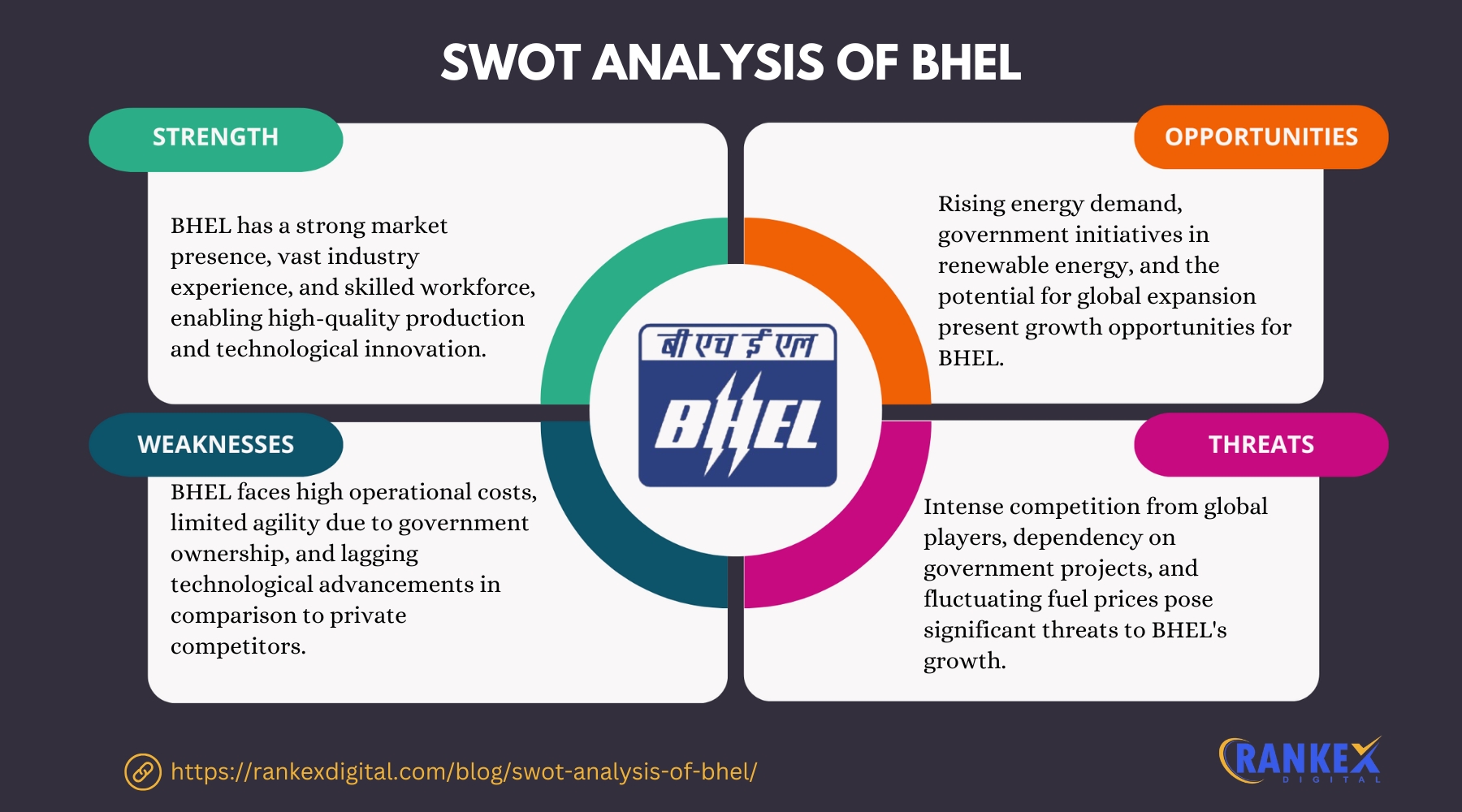
Strengths of BHEL (Bharat Heavy Electricals Limited)
- Extensive Manufacturing Capability: BHEL’s manufacturing facilities are among the largest in India, allowing it to handle high production volumes and fulfill large orders, including complex and customized solutions for a variety of industries. This capacity provides BHEL a competitive edge, making it well-suited to supply India’s energy and industrial demands on a large scale.
- Strong Domestic Market Presence: As a major player in India’s power equipment sector, BHEL is highly trusted among Indian industries and government entities. Its established market presence in India builds customer loyalty and a strong brand reputation, ensuring consistent demand for its products.
- Government Support: As a public sector undertaking, BHEL benefits from the Indian government’s support, which includes financial assistance, strategic guidance, and access to government contracts. This support offers stability and an advantage in competitive bidding processes, especially for government-led infrastructure projects.
- Broad Product Portfolio: BHEL serves multiple sectors with a diverse array of products, ranging from power and transportation equipment to renewable energy solutions. This variety allows BHEL to mitigate risks by diversifying across sectors, enabling it to tap into multiple revenue streams.
- In-house Research & Development (R&D): BHEL’s R&D capabilities highlight its commitment to developing innovative and sustainable technologies, particularly in response to evolving environmental standards and renewable energy trends. By investing in R&D, BHEL can continuously improve its product quality, cost-efficiency, and technological advancement.
Weaknesses of BHEL
- Dependence on Government Projects: A significant portion of BHEL’s revenue is derived from government projects. This dependency makes BHEL vulnerable to delays and uncertainties related to government funding and project execution timelines, which can impact its cash flow and project schedules.
- Limited International Presence: While BHEL is strong domestically, its footprint in the international market is limited compared to global competitors like Siemens and GE. This restriction limits BHEL’s potential to access new markets, reduce dependency on the Indian market, and increase revenue through global expansion.
- High Operational Costs: BHEL’s large workforce and extensive infrastructure result in high operational costs, which impacts its profitability. Operational expenses, including labor costs and maintenance, pose a challenge to BHEL’s financial efficiency and flexibility in pricing.
- Slow Decision-making: Being a public sector company, BHEL is sometimes hindered by bureaucratic processes and slower decision-making. This affects its agility to respond quickly to market changes or adopt innovative business practices, which can limit its competitiveness in the fast-paced technology sector.
- Aging Workforce: A large portion of BHEL’s workforce is approaching retirement age, posing challenges for skill continuity and operational efficiency. Without adequate succession planning and workforce rejuvenation, BHEL may face skill shortages, impacting its productivity and innovation capacity.
Opportunities for BHEL
- Renewable Energy Expansion: With a growing global and domestic emphasis on renewable energy, BHEL has significant opportunities to expand into solar, wind, and green hydrogen sectors. Leveraging its manufacturing expertise, BHEL can tap into the renewable energy market and align itself with India’s clean energy targets.
- Growth in Domestic Infrastructure: India’s ongoing infrastructure development initiatives, especially in power generation and industrial sectors, increase demand for BHEL’s products. This domestic growth presents opportunities for BHEL to secure more contracts and enhance its market share in infrastructure-related projects.
- International Market Expansion: Emerging markets, such as those in Africa and Southeast Asia, are experiencing rapid demand for power infrastructure. By expanding into these regions, BHEL could establish a presence in high-growth markets, reducing reliance on domestic contracts and increasing its revenue base.
- Digital Transformation: Embracing digital technologies to modernize its operations could help BHEL improve efficiency, reduce operational costs, and enhance customer satisfaction. By adopting advanced manufacturing techniques and digital tools, BHEL can streamline production and stay competitive with global players.
- Strategic Partnerships: Collaborating with international technology providers can help BHEL bring cutting-edge products to the Indian market. Partnerships in renewable energy, digital technology, and advanced manufacturing could bolster BHEL’s capabilities, enabling it to expand its product range and enter new markets more effectively.
Threats to BHEL
- Intense Competition: BHEL faces stiff competition from both domestic and international companies, particularly those that offer advanced technological solutions and are already established in global markets. Companies like Siemens and GE pose significant threats with their innovative products, which may be more efficient or cost-effective than BHEL’s offerings.
- Technological Disruption: As technology in renewable energy evolves rapidly, BHEL needs to continually invest in innovation to keep its offerings relevant. Failure to keep pace with new technologies could lead to outdated products, especially in the renewable energy sector, where customer expectations are rapidly evolving.
- Economic Slowdowns: Any slowdown in the economy, particularly in government spending, can severely impact BHEL’s revenues. As BHEL depends largely on government projects, economic challenges and budget cuts could reduce the number and scale of available projects.
- Regulatory Challenges: Compliance with environmental and energy regulations can be costly and may require BHEL to make continuous adjustments in its operations. Shifts in government policy, especially around fossil fuels and environmental standards, could increase operational costs and impact BHEL’s project timelines.
- Dependence on Thermal Power: As the energy market shifts toward cleaner alternatives, BHEL’s reliance on thermal power projects poses a long-term risk. With a growing preference for renewable energy sources, BHEL’s investments and expertise in thermal power may become less valuable, affecting its market position.
Top Competitors of BHEL
- Larsen & Toubro (L&T)
- Siemens India
- General Electric (GE)
- ABB India
- Thermax
Conclusion
The SWOT analysis of BHEL shows that its extensive manufacturing capabilities, broad product portfolio, and government support are critical strengths. However, challenges like high operational costs, slow decision-making, and reliance on government contracts remain significant hurdles.
The future opportunities for BHEL lie in renewable energy, international market expansion, and digital transformation, while threats from intense competition, economic fluctuations, and regulatory challenges cannot be overlooked. By leveraging its strengths, addressing weaknesses, and proactively seizing emerging opportunities, BHEL can maintain its leadership position in India’s industrial landscape.
Frequently Asked Questions
- What are BHEL’s main strengths?
BHEL’s primary strengths include its extensive manufacturing capabilities, strong domestic market presence, government support, diverse product portfolio, and commitment to in-house R&D. - What weaknesses does BHEL face as a public sector enterprise?
BHEL’s weaknesses include its reliance on government contracts, limited international reach, high operational costs, bureaucratic decision-making, and an aging workforce. - How can BHEL capitalize on renewable energy opportunities?
BHEL can focus on expanding its renewable energy projects, particularly in solar, wind, and green hydrogen, aligning with global sustainability trends and government policies. - What are the key threats to BHEL’s market position?
Key threats include intense competition from global firms, technological disruption in the energy sector, economic slowdowns, regulatory challenges, and the shift from thermal to clean energy. - What opportunities does BHEL have for future growth?
Opportunities for BHEL include digital transformation, expanding renewable energy projects, tapping into international markets, and forming strategic partnerships to enhance its technological edge and market reach.

